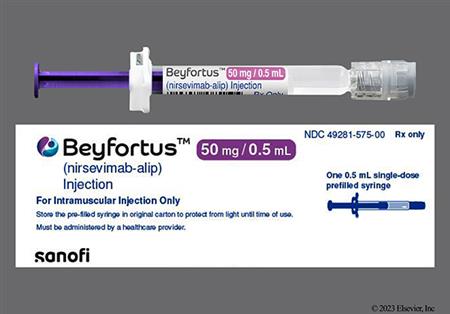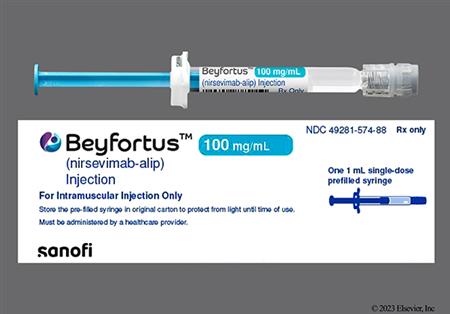ThisiscontentfromElsevier'sDrugInformation
Nirsevimab
Learn more about Elsevier’s Drug Information today! Get the reliable drug data and decision support you need to enhance patient safety through timely and accessible information.
General Dosing Information
AAP/ACIP Recommendations
100 mg IM once.[69197]
50 mg IM once.[69197]
200 mg IM once. Administer as 2 IM injections (2 x 100 mg).[69197]
100 mg IM as an additional dose. Administer as soon as the patient is stable after surgery to ensure adequate nirsevimab serum concentrations.[69197]
50 mg IM as an additional dose. Administer as soon as the patient is stable after surgery to ensure adequate nirsevimab serum concentrations.
50 mg IM as an additional dose. Administer as soon as the patient is stable after surgery to ensure adequate nirsevimab serum concentrations.[69197]
200 mg IM as an additional dose. Administer as 2 IM injections (2 x 100 mg) as soon as the patient is stable after surgery to ensure adequate nirsevimab serum concentrations.[69197]
100 mg IM as an additional dose. Administer as soon as the patient is stable after surgery to ensure adequate nirsevimab serum concentrations.[69197]
Safety and efficacy have not been established.
Safety and efficacy have not been established.
Safety and efficacy have not been established.
older than 24 months: Safety and efficacy have not been established.
12 to 24 months: 200 mg IM.
weighing 5 kg or more: 200 mg IM.
weighing less than 5 kg: 50 mg IM.
weighing 5 kg or more: 100 mg IM.
weighing less than 5 kg: 50 mg IM.
Specific guidelines for dosage adjustments in hepatic impairment are not available; it appears that no dosage adjustments are needed.
Specific guidelines for dosage adjustments in renal impairment are not available; it appears that no dosage adjustments are needed.
† Off-label indication

Nirsevimab is an intramuscular monoclonal antibody indicated for the prevention of respiratory syncytial virus (RSV) lower respiratory tract disease in neonates and infants in their first RSV season or children 24 months of age or younger who are at risk of severe RSV disease in their second season. The efficacy of nirsevimab was studied in double-blind, placebo-controlled trials as well as a controlled trial with palivizumab. In a clinical trial involving pediatric patients 29 to younger than 35 weeks gestational age, patients (n = 969) receiving nirsevimab had a lower incidence of medically attended RSV lower respiratory tract infection (MA RSV LRTI) (2.6%) vs. placebo (9.5%) through 150 days post dose. The efficacy of nirsevimab for MA RSV LRTI requiring hospitalization based on relative risk reduction was 78.4% (95% CI 51.9, 90.3; p = 0.0002). In pediatric patients with a gestational age older than 35 weeks, the incidence of MA RSV LRTI occurred in 1.2% of patients receiving nirsevimab (n = 994) vs. 5% of patients receiving placebo. The efficacy of nirsevimab for MA RSV LRTI requiring hospitalization based on relative risk reduction was 60.2% (95% CI -14.6, 86.2; p = 0.09). Clinical trials, involving patients with a gestational age younger than 35 weeks with chronic lung disease of prematurity (CLD) or hemodynamically significant congenital heart disease (CHD) during their first RSV season (n = 616), reported the incidence of MA RSV LRTI as 0.6% in those receiving nirsevimab and 1% in the group receiving palivizumab through 150 days post dose. There were no reported cases of MA RSV LRTI during the second season of RSV in patients receiving nirsevimab or palivizumab. The duration of protection offered by a single dose of nirsevimab extends through 5 months.[69197]
For storage information, see the specific product information within the How Supplied section.
Serious hypersensitivity reactions, including urticaria, dyspnea, cyanosis, and/or hypotonia, have occurred after nirsevimab administration. Anaphylactoid reactions have been reported after administration of human immunoglobulin G1 monoclonal antibodies, such as nirsevimab. Initiate appropriate treatment if signs and symptoms of a serious hypersensitivity reaction or anaphylaxis occurs. Rash, including macular rash, maculopapular rash, and papular rash, was reported within 14 days post dose in approximately 1% of pediatric patients receiving nirsevimab in clinical trials (n = 2,570).[69197]
Injection site reaction, including pain, induration, edema, and swelling, was reported within 7 days post dose in 0.3% of pediatric patients receiving nirsevimab in clinical trials (n = 2,570).[69197]
Antibody formation can occur with nirsevimab use. During 4 clinical trials, anti-drug antibodies (ADA) were present in 3.3% to 13% of patients after treatment. Among patients with ADA antibodies, 0% to 21% of patients tested positive for neutralizing antibodies against nirsevimab. Of those patients, 62% to 100% were positive for ADA against triple amino acid substitution (YTE) in the Fc region. Patients who developed anti-nirsevimab antibodies had reduced nirsevimab concentrations at Day 361 (40% to 60% lower compared to patients who received nirsevimab and did not develop anti-nirsevimab antibodies). The effect of ADA on the effectiveness of nirsevimab is unknown.[69197]
The coadministration of certain medications may lead to harm and require avoidance or therapy modification; review all drug interactions prior to concomitant use of other medications.
This medication is contraindicated in patients with a history of hypersensitivity to it or any of its components.
Nirsevimab is administered intramuscularly; use with caution in individuals with thrombocytopenia or any bleeding disorder.[69197]
Nirsevimab is not approved for use in patients of reproductive potential. Therefore, no data are available to assess pregnancy risks.[69197]
Nirsevimab is not approved for use in patients of reproductive potential. Therefore, no data are available on its use during breast-feeding.[69197]
Nirsevimab is a respiratory syncytial virus (RSV) fusion (F) protein-directed fusion inhibitor. It is a recombinant immunoglobulin G1 kappa (IgG1K) monoclonal antibody that provides passive immunity against RSV. It targets the prefusion conformation of the RSV F protein. Nirsevimab inhibits RSV activity by impeding changes in the F protein needed for the virus to attach to the cellular membrane and gain viral entry. Nirsevimab has long acting activity due to a triple amino acid substitution in the Fc region. This modification allows for increased binding to the neonatal Fc receptor and thus extends the serum half-life.[69197]
Revision Date: 07/16/2025, 01:54:27 PMNirsevimab is administered via intramuscular injection. The Vd is approximately 477 mL, for an infant weighing 5 kg. Nirsevimab is metabolized into small peptides by catabolic pathways. The estimated clearance, for an infant weighing 5 kg, is 3.42 mL/day. The estimated half-life is 71 days. Protection against the respiratory syncytial virus (RSV) is estimated to extend through 5 months.[69197]
Affected cytochrome P450 isoenzymes: none [69197]
The estimated absolute bioavailability of nirsevimab is 84%. The estimated median Tmax is 6 days (range 1, 28 days). There is a positive correlation between serum nirsevimab and a lower incidence of medically attended RSV lower respiratory tract infection when the AUC (based on clearance at baseline) is above 12.8 mg x day/mL. In adults, after IM administration of nirsevimab, RSV neutralizing antibody concentrations in the serum were approximately 4 times higher than at baseline 8 hours after the nirsevimab dose. The maximum concentrations were reached by day 6 after IM administration in adults.[69197]
Hepatic impairment is not expected to alter the pharmacokinetics of nirsevimab.[69197]
Renal impairment is not expected to alter the pharmacokinetics of nirsevimab.[69197]
In pediatric patients, the pharmacokinetics of nirsevimab were dose proportional after IM administration of doses ranging from 25 to 200 mg. After receiving the recommended dose, nirsevimab serum exposures were similar in neonates and infants born during or entering their first RSV season, neonates and infants born at younger than 35 weeks gestational age entering their first RSV season, and in pediatric patients up to 24 months with chronic lung disease or congenital heart disease in their first or second RSV season.[69197]
No clinically significant differences in the pharmacokinetics of nirsevimab were observed based on race.[69197]
No clinically significant differences in the pharmacokinetics of nirsevimab were observed based on disease state, such as chronic lung disease, congenital heart diease, or immunocompromised states.[69197]
Nirsevimab is not approved for use in patients of reproductive potential. Therefore, no data are available to assess pregnancy risks.[69197]
Nirsevimab is not approved for use in patients of reproductive potential. Therefore, no data are available on its use during breast-feeding.[69197]
Cookies are used by this site. To decline or learn more, visit our cookie notice.
Copyright © 2025 Elsevier, its licensors, and contributors. All rights are reserved, including those for text and data mining, AI training, and similar technologies.